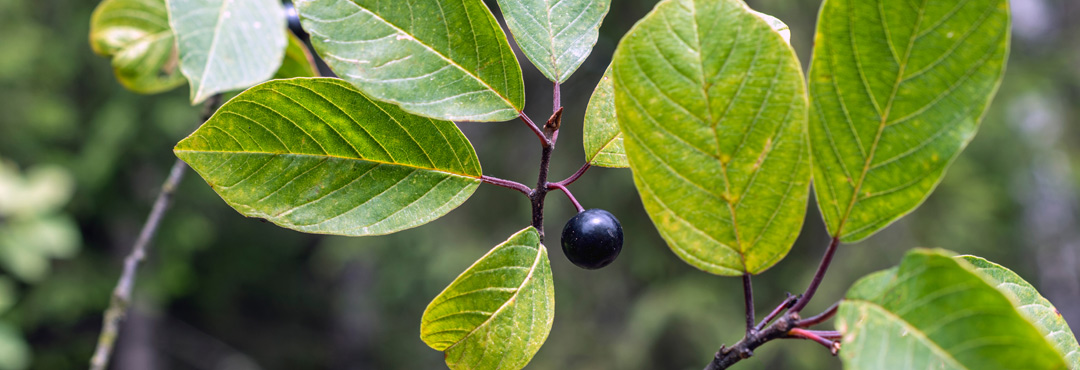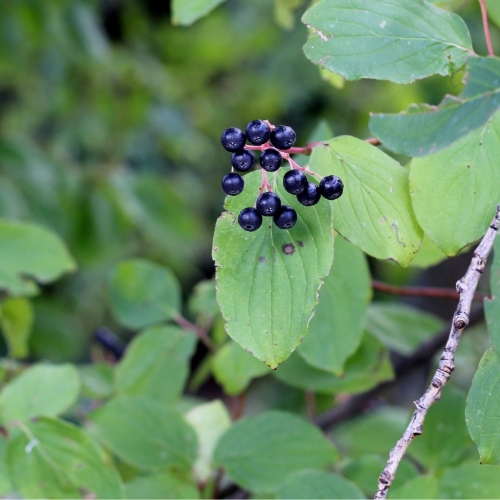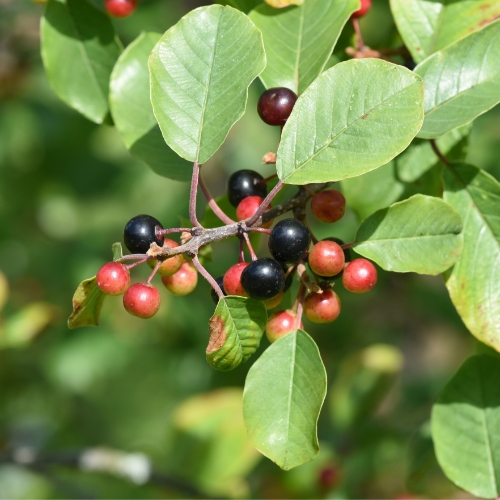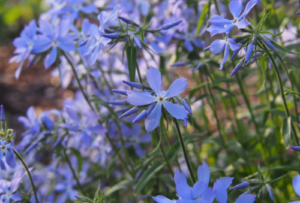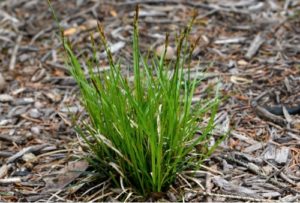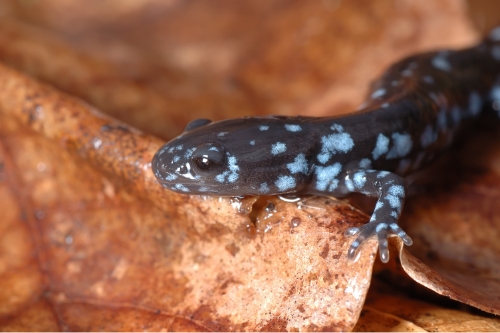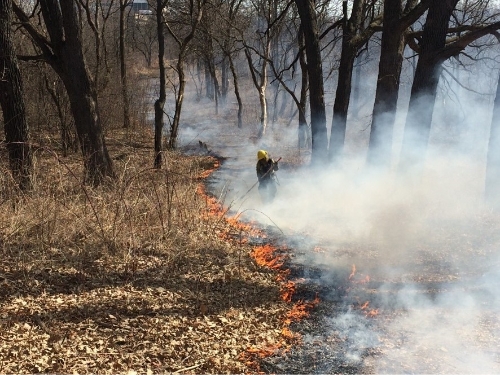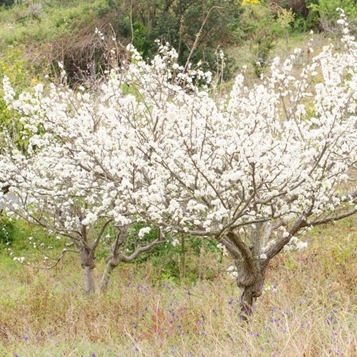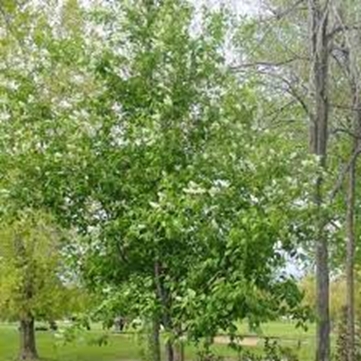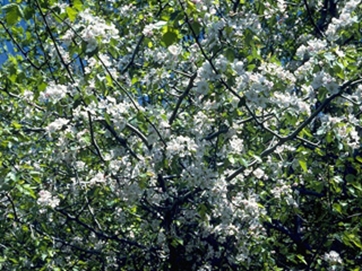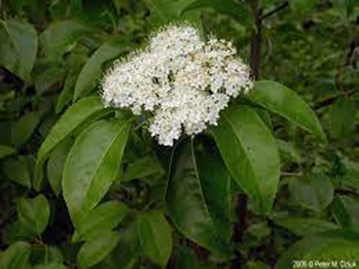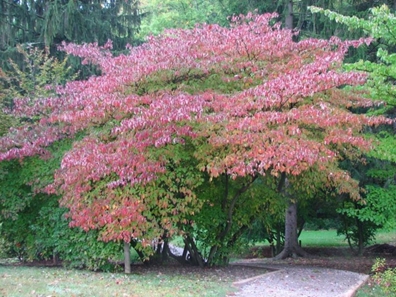What is Buckthorn?
Buckthorn is a non-native, highly invasive woody plant that ranges in size from a shrub to a small tree, reaching heights of up to 22 feet. The name is attributed to the woody spine on the end of each twig in many species. Two species of buckthorn, Common Buckthorn (Rhamnus cathartica) and Glossy Buckthorn (Rhamnus frangula), now occupy just about every corner of where we live here in the Midwest, from natural areas to our own backyards.
Common buckthorn is found in uplands where it is dry while glossy buckthorn tends to occur more often in wet areas. Both species of buckthorns occur in a wide variety of habitats, tolerate shade and drought, and spread quickly by seed. Common buckthorn leaves are sharp and pointed and have somewhat finely rounded teeth. Glossy buckthorn leaves are shiny on the upper surface, oval and slightly wavy. An easy way to identify buckthorn is that it is one of the first trees to leaf out in the spring as well as the last to lose its leaves into the winter well after our native shrubs and trees have dropped their leaves.
- Common buckthorn leaves
- Glossy buckthorn leaves
Why Should You Remove Buckthorn?
A tree is a tree and all things green are good, right? Afraid not. Buckthorn is bad. Very bad. It aggressively invades natural areas and forms dense thickets, making it very challenging for native species to grow and persist. Because buckthorn leafs out very early in the growing season and keeps its leaves late into the fall native trees, shrubs and wildflowers are shaded out and as a result struggle to grow. Of special concern in our region, buckthorn prevents the growth of young oaks and hickories which once dominated our landscapes but are now declining at rapid rates.
- Woodland Phlox
- Pennsylvania Sedge
- White Oak Sapling
Woodland Phlox, Pennsylvania Sedge and White Oak saplings are just a small sampling of native plants that struggle to survive in a buckthorn-dominated landscape.
Buckthorn is a prolific berry-producer and seeds are widely dispersed by birds. However, buckthorn berries have poor nutritional value for birds due to the laxative effect that the berries have on them. Buckthorn also produces chemicals that change the properties of the soil where it grows, making the soil toxic to creatures like the blue-spotted salamander and other amphibians. Finally, buckthorn leaves break down very rapidly, exposing bare soils which leads to erosion. Not to mention the bare soil provides the perfect opportunity for even more buckthorn to grow!
- Blue-spotted salamander (Ambystoma laterale)
How Do We Remove Buckthorn?
ILM is deeply committed to our role in making our local environments healthier and we are thrilled when people ask us to remove their buckthorn! There are many methods for removing buckthorn, depending on the size of the tree, the amount of buckthorn present and the location.
Foliar Spraying
Buckthorn saplings can be controlled by applying herbicide to their leaves. Since buckthorn leafs out earlier than native species and stays green well after native trees and shrubs go dormant, our certified pesticide applicators target buckthorn saplings in the spring and fall when natives are not present. Factors considered when selecting an herbicide for use on a particular site include proximity to water or wetlands and the presence or absence of desirable native vegetation.
Hand Cutting
Larger buckthorn trees are cut near the ground using a chainsaw. To prevent resprouting, certified pesticide applicators need to apply herbicide to the stump immediately after cutting. The best time to cut buckthorn and herbicide the stump is in the winter when desirable plants are dormant. Disposal methods of the cut material include chipping the material and hauling it off site or burning the material in brush piles.
Forestry Mowing
The most economic approach to removing dense thickets of buckthorn is to use a forestry mower. Forestry mowers can consume buckthorn trees up to 6-inches in diameter and shred the trees into coarse mulch. Since forestry mowers are considered heavy equipment, we wait until winter when there is frozen ground to prevent soil compaction and rutting. Another option is to mount a mower head on our low ground-pressure amphibious equipment in scenarios where the ground stays wet (wetlands) or in areas where the soil is loose and never fully freezes. Stumps need to be treated with herbicide to prevent or minimize resprouts in the spring. A water-based herbicide can be utilized immediately after mowing and an oil-based herbicide can be used some time after stumps are cut if heavy snow delays stump treatment. This oil-based herbicide cannot be used in wet areas, however, as it will travel through the water. In this case, stumps need to be treated with an aquatic-approved herbicide to prevent resprouts.
Buckthorn seedlings are vulnerable to fire due to their immature root structure. Using prescribed fire as a control method is an option to prevent seedlings from growing into trees in more established natural areas. The success of fire as a buckthorn management tool is dependent on achieving high heat, which is dependent on how much fuel is present to feed the fire. Prescribed fire is most successful in settings with high fuels such as prairies as well as woodlands dominated by Oak and Hickory trees. Tall prairie grasses or thick leaf litter create the intense heat needed to control buckthorn saplings.
- Prescribed fire can be an effective tool for killing buckthorn saplings
But I Like the Privacy Buckthorn Provides!
People are sometimes resistant to removing buckthorn since it provides great privacy screening. There are excellent native replacement options that offer privacy with the added benefit of providing the ecological diversity that supports healthy ecosystems. Healthy ecosystems are important for not just wildlife, but for people, too!
Here are a few native privacy screening replacement options that are more readily available from local nurseries.
- American Plum (Prunus americana)
- Choke Cherry (Prunus virginiana)
- Downy Hawthorn (Crataegus mollis)
- Nannyberry (Viburnum lentago)
- Pagoda Dogwood (Cornus alternifolia)
- Eastern Redbud (Cercis canadensis)

